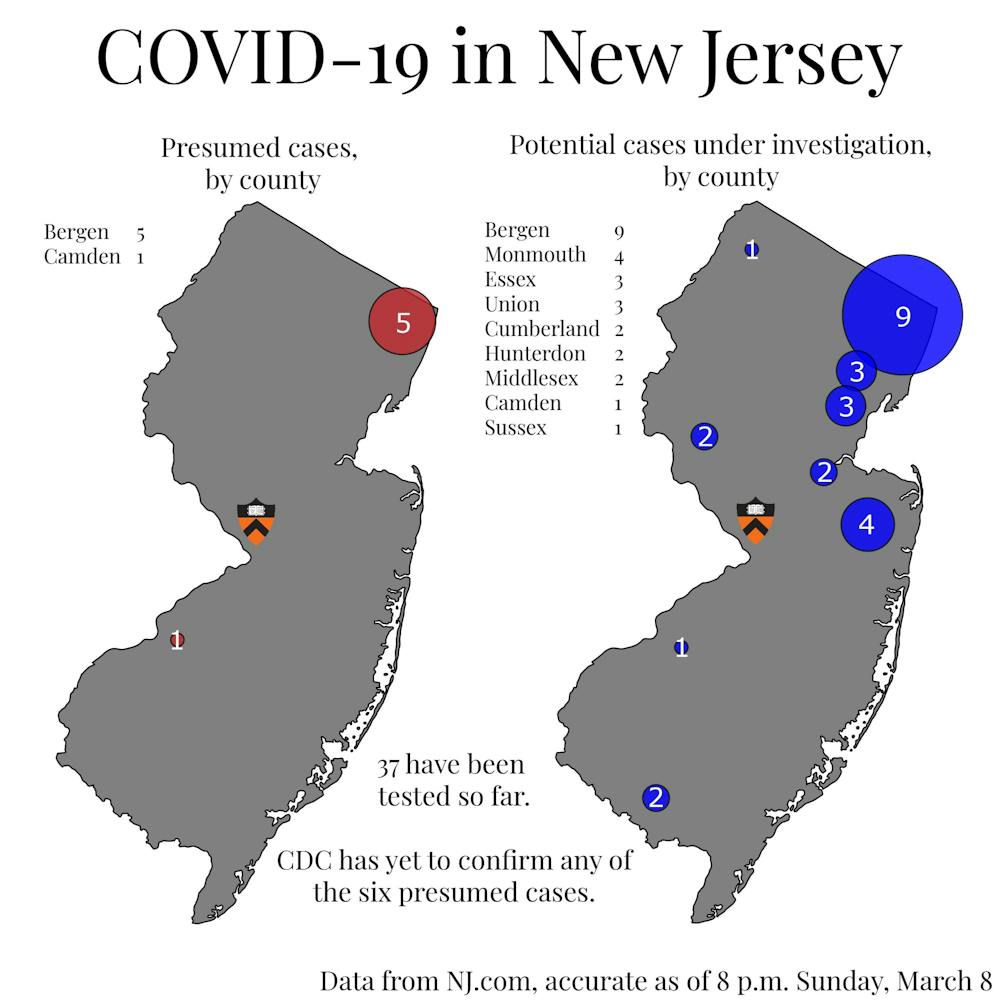A potential case of COVID-19 in Mercer County has tested negative, according to state health officials. Of the four cases that underwent testing this weekend, two patients tested positive, bringing the total number of cases in New Jersey to six, as of March 8.
“A team of experienced professionals from across the University” are monitoring the situation closely, according to a previous statement issued by Deputy University Spokesperson Mike Hotchkiss to The Daily Princetonian.
“The emergence of COVID-19 cases in our state is not a surprise but serves as a reminder of the importance of our preparations,” he wrote.
According to Planet Princeton, the Centers for Disease Control and Prevention (CDC) has not yet “officially confirmed any of the positive tests in New Jersey,” noting instead that “[s]tate officials refer to the New Jersey cases as ‘presumed positive.’”
Around the University, convenience stores are seeing depleted supplies of certain health-related items as a consequence of the virus’s increasing threat.
Employees of both the CVS at 100 Nassau St. and the Wawa at 152 Alexander St. confirmed that the stores do not currently have any face masks or hand sanitizer in stock, despite usually carrying both products. An employee of the University Store at 36 University Pl. noted that, while it does not sell facemasks, the establishment has sold out of Purell Hand Sanitizer.
On Saturday, Hotchkiss noted in a statement to the ‘Prince’ that staff including but not limited to individuals from University Health Services, the Office of International Programs, Public Safety, Campus Dining, Housing & Real Estate Services, Facilities, and the Office of Communications are working “through the weekend, taking steps that range from enhanced cleaning of commonly touched surfaces, to supporting students abroad, to preparing resources for online instruction, if needed.”
A number of the University’s peer institutions have begun reacting to the outbreak.

“We will continue to monitor the situation and will make policy changes as necessary,” Hotchkiss noted in a statement to the ‘Prince.’
In an email on Sunday evening, Columbia University President Lee Bollinger announced that the school will suspend classes on Monday and Tuesday “to prepare to shift to remote classes for the remainder of that week.” Bollinger announced the decision after “a member of [the Columbia] community [was] ... quarantined as a result of exposure to the coronavirus (COVID-19)...”
Though classes will be online, “the decision … does not mean that the University is shutting down,” wrote Bollinger. “All non-classroom activities … will continue in accordance with the new travel and events restrictions announced recently. At this point, just to restate what is important to know, we do not have a confirmed case of the virus on campus.”
“If anything, I feel like it’s over-cautious, but I guess that's better than being under-cautious,” said Zuri Mabrey-Wakefield, a first-year student at Barnard College. “Beyond classes, there’s not much that’s cancelled or changed in campus life.”

Mabrey-Wakefield further described the sentiment on campus as “a little weird.”
“We just got the email a couple of minutes ago,” she said. “A lot of people were heard on the phone with their parents and loved ones, but then I think that gave way to kind of a levity and a joking mood, almost. There immediately were jokes going around about how there [was] a mass exodus staged at the library when the email came out.”
On Saturday, The Stanford Daily reported that Stanford University cancelled “all in-person class meetings for the last two weeks of winter quarter.” The announcement shortly followed a notice that a faculty member in the Stanford School of Medicine had tested positive for coronavirus. While the school is now conducting all classes online, sources noted to the ‘Prince’ that each professor will be given discretion with regard to the manner in which they continue work.
“I can’t think of anything else they could do better,” said Brendan McLaughlin, a first-year student at Stanford.
Stanford Provost Persis Drell announced in an email on Friday that “Stanford has two undergraduate students in self-isolation after possible exposure to COVID-19.”
“It would be very difficult to control the spread of the virus on campus and, since there are concerns that it is present in the student body, I think it makes sense to let people leave if they want to,” said Jenna Mansueto, a first-year student at Stanford.
Mansueto further noted that the notice of the undergraduates in self-isolation, combined with the knowledge that classes are going to be conducted online, prompted a number of students to leave swiftly.
“A lot of people have left already,” she explained. “Some people left within hours of getting the email. It seems like some people are moving out, not just taking stuff for three weeks. I saw people taking their [digital] monitors out of their rooms. It looks like they’re not going to be back for a long time.”
According to The New York Times, as of Sunday evening, “the coronavirus outbreak has sickened more than 109,900 people,” including at least 545 confirmed cases, and 22 deaths, in the United States.
Washington leads the nation with 141 confirmed cases while California and New York, home to Stanford and Columbia respectively, follow with 111 and 106. One person in California has died from the virus, while New York has not seen any deaths.
In response to the outbreak, California, New York, Washington, Florida, Kentucky, Utah, Maryland, and Oregon have declared states of emergency.
As of Sunday evening, New Jersey has not declared a state of emergency, nor has the state witnessed any fatalities as a consequence of COVID-19.








